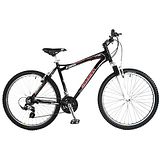BarelyAWake
New Member
That "80% strength loss" quote is most likely referring to a thick material multiple pass or TIG w/o filler - ie an absolute worst case scenario & not applicable.
Look into using 7005 instead of 6061 as it does not require heat treating & can be naturally aged. It's often used in bike frames & where heat treatment cannot be done after welding. Almost all aluminum bicycles are are designed utilizing a somewhat heavier gauge than the minimum possible, the joint design usually includes gusseting w/this in mind.
http://www.sapagroup.com/pages/493467/Answer Book/11_Welding.pdf
http://forums.mtbr.com/frame-building/aluminium-6061-7005-a-607488.html
If you don't like aluminum, don't use it - but it is commonplace regardless & readily utilized in bicycle manufacturing & fabrication, both heat treated and non-heat treated, artificially or naturally aged, or simply compensating for the material's characteristics.
Look into using 7005 instead of 6061 as it does not require heat treating & can be naturally aged. It's often used in bike frames & where heat treatment cannot be done after welding. Almost all aluminum bicycles are are designed utilizing a somewhat heavier gauge than the minimum possible, the joint design usually includes gusseting w/this in mind.
http://www.sapagroup.com/pages/493467/Answer Book/11_Welding.pdf
http://forums.mtbr.com/frame-building/aluminium-6061-7005-a-607488.html
If you don't like aluminum, don't use it - but it is commonplace regardless & readily utilized in bicycle manufacturing & fabrication, both heat treated and non-heat treated, artificially or naturally aged, or simply compensating for the material's characteristics.
It all boils down to common sense, if you start with an overbuilt platform (such as a mountain bike) of even average acceptable quality (wall thickness & factory welds) and are familiar with basic construction & engineering concepts - welding/modifying any material is simply a matter of considering "acceptable risk" and compensating as necessary...
...yet if you are not familiar with such basic construction & engineering concepts and/or utilize only the lowest quality/most inexpensive platforms to modify in any way (including simply motorizing something not designed for such) - no material is "safe" and it all entails some amount of risk. If you have even some fabrication & modification experience, using aluminum has no greater risk then steel - yet if you have little to no experience in fabrication and welding, the material alone won't make any difference.
Again, it's not so much about the material used - it's the design that material is used in that needs be considered, the care & quality in which it's constructed... and that's so variable with our hobby, there's no clear cut rules, no easy answers - for every post warning against aluminum there's an equal or greater number of reported steel frame failures. Every motorized bicycle on this forum has been modified well beyond it's initial operating parameters, every one a risk to some degree - simply focusing on the material used without considering it's design is the fundamental mistake here, most focusing on price and/or aesthetics alone.
Last edited:













